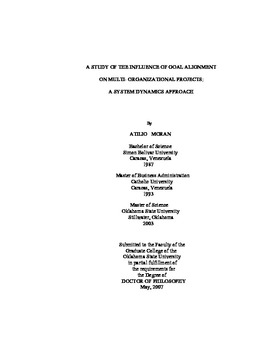| dc.contributor.advisor | Rossler, Paul E. | |
| dc.contributor.author | Moran, Atilio | |
| dc.date.accessioned | 2013-12-10T18:05:04Z | |
| dc.date.available | 2013-12-10T18:05:04Z | |
| dc.date.issued | 2007-05 | |
| dc.identifier.uri | https://hdl.handle.net/11244/7776 | |
| dc.description.abstract | Scope and Method of Study: The purpose of this study is to examine how the level of goal alignment among the participant organizations in a multi-organizational project influences project dynamics and performance. Two projects cases were used in the study. Two system dynamics models were developed based on cases' data and previously validated projects system dynamics models. The first model aims to represent how the level of goal alignment affects project dynamics when a project team constituted by representatives of the different participating organizations executes the project. The second model aims to represent the case when the project team manages the project, which is executed by a third party. An assessment of the models' validity was performed by participants in the projects studied. An assessment of the possible use of the models in other contexts was performed through questionnaires completed by a panel of experts, and by comparison of the models' structures to previous research findings in related areas. Simulation experiments were performed to examine to what extent the models outputs represent plausible projects system behaviors according to the cases' data, and to explore the effects of possible moderating factors. | |
| dc.description.abstract | Findings and Conclusions: A pattern was identified in the cases studied concerning the mechanism through which the level of goal alignment affected project performance. That mechanism is the variation of the level of communication and trust among partners. In one case, the low level of communication affected the quality of the tasks that had to be coordinated between partners, as well as the coordination required for resources deployment. In the second case, low levels of trust and communication limited the project team problem solving capabilities, leading to delays in the decision making processes and to the elevation of the conflict to higher levels of management, increasing even more the decision making delays. The delays in the decision making process led to the accumulation of problems to solve, hindering the team effort to be proactive in anticipating incoming problems that might affect project performance. Models' assessments and simulations outputs provide preliminary confidence in models' structures, which can be improved with additional cases replications. | |
| dc.format | application/pdf | |
| dc.language | en_US | |
| dc.rights | Copyright is held by the author who has granted the Oklahoma State University Library the non-exclusive right to share this material in its institutional repository. Contact Digital Library Services at lib-dls@okstate.edu or 405-744-9161 for the permission policy on the use, reproduction or distribution of this material. | |
| dc.title | Study of the influence of goal alignment on multi-organizational projects: A system dynamics approach | |
| dc.contributor.committeeMember | Pratt, David B. | |
| dc.contributor.committeeMember | DeYong, Camille F. | |
| dc.contributor.committeeMember | Yauch, Charlene A. | |
| dc.contributor.committeeMember | Romano, Nicholas C. | |
| osu.filename | Moran_okstate_0664D_2285.pdf | |
| osu.accesstype | Open Access | |
| dc.type.genre | Dissertation | |
| dc.type.material | Text | |
| thesis.degree.discipline | Industrial Engineering and Management | |
| thesis.degree.grantor | Oklahoma State University | |
